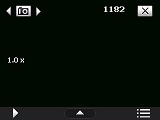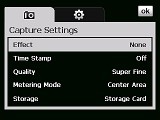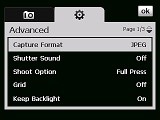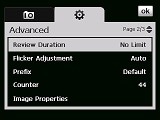HTC Touch Cruise review: Happy cruising
Happy Cruising
Audio and video players - video let down by the processor
The primary multimedia player of all Windows Mobile devices is the preinstalled Windows Media Player. Besides music, it allows watching video and streaming TV. You can sort tracks by artist, album or genre and you can create custom playlists.
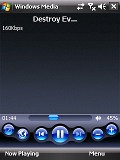

The Windows Media player and the Streaming media application user interface
HTC have additionally installed the Audio Manager music player. It is a strange name for a music player but it does allow you to manage your music files easily - you can sort tracks by artist, album, genre, or composer. You can create an unlimited number of custom playlists and the interface is optimized for finger operation.
The Streaming Media application is another HTC touch to the software package of the Touch Cruise. It allows you to watch or listen to streaming content. It follows the same stylus-free design of the Audio Manager.
To our greatest disappointment, the HTC Touch Cruise, much like the HTC TyTN II couldn't play movies at near-VGA resolution smoothly. We were forced to convert those to near-QVGA in order to play them properly. This doesn't speak highly of the 400MHz processor, as those kind of limitations used to apply to 200MHz PocketPCs such as the old but trustworthy Qtek 9100 (HTC Wizard).
We installed a TCPMP player and the needed codecs to play DivX and XviD video files. Playing movies at near-VGA resolution on the Cruise is impossible, unless the GDI mode of the player is used. In this mode the dropped frames are considerably less and the film is almost possible to watch.
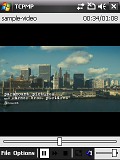

Watching a DivX movie on the HTC Touch Cruise is not a pleasurable experience
There seems to be a long history behind this problem, as the HTC users are guessing that the problem lies in the lack of video drives for the newest HTC devices. According to the official specs of the Qualcomm MSM7200, it should include dedicated video acceleration hardware but the video playback performance suggests nothing like that. So HTC users that own any of the HTC devices based on that particular chipset are guessing that the recent HTC devices are not making use of the hardware due to a simple lack of drivers by HTC. Here you can find out more about the problem.
The nice camera is ruined by the image processing
PocketPC are probably bottom of the food chain when it comes to camera performance. And, believe us, it's not about the megapixel count. At least, not only about it. It's just that their photos hardly stand comparison to what other devices on the market deliver. HTC were obviously addressing this issue and have released a few devices with some serious photography power recently. The HTC TyTN II's camera was probably the first and now the Touch Cruise was supposed to follow the trodden path. As it turns out though, the second attempt wasn't as successful as the first one.
As you probably imagine, the 2.8" TFT display is a really nice camera viewfinder to have. The Touch Cruise camera can be operated as a regular digital camera - a half press on the shutter key locks the auto focus and exposure, while pressing the key all the way down takes the actual shot. However, the camera key requires a severe amount of pressure in order to take a picture. This is probably something you will get used to but we simply don't see the reason for such a difficult-to-push button. It resulted in quite a number of missed shots for us the first few days.
On the other hand, there is a nice camera menu, which is easy to operate with your fingers only. White balance can be either automatic or custom set to daylight, night, incandescent or fluorescent. You can apply several color effects (Grayscale, Sepia, Cool, Negative) and use the special camera modes such as Panorama, Sports and Burst.
There are several shooting modes including Burst and Sport modes. The Panorama mode allows the camera to take three slightly overlapping images and automatically stitch them to create a panoramic shot. However, each individual shot is taken again at VGA resolution only. There is also a self-timer and exposure compensation. The camera can also apply Date stamps to your photos. Should you choose, you can also use the front video-call camera to take pictures and video.
As you will notice, the image quality is not really on par with the best 3 megapixel cameraphones such as the Sony Ericsson K800, for example. The images suffer in terms of dynamic range. The colors are spot-on on most occasions and the macros come out just fine thanks to the auto focus.
However, the strange pattern we saw in the top right angle in the photos produced by HTC TyTN II was also visible here. Furthermore, the situation with the Cruise is much worse, as it appears all over the pictures - on every low contrast bit. It's most clearly visible when the pictures are viewed on a computer screen with zoom. It is really a software issue, showing that the photo processing algorithm is messed up but nonetheless the result isn't pleasant at all.








Sample photos from HTC Touch Cruise's camera
Update: The good news is that the pattern is dealt with a dedicated patch for the HTC Touch Cruise released by HTC. Here is a photo made with the Cruise after the patching where you can clearly see the difference.

Sample photos from HTC Touch Cruise's camera after the patch
An intriguing feature is that with some registry tweaking you can make the device store GPS information in the EXIF of your snapshots. It comes handy, as you can later upload them to a GPS-enabled photo sharing portal and it will accurately report the location where the pictures were taken.
| "...To our greatest disappointment, the HTC Touch Cruise, much like the HTC TyTN II couldn't play movies at near-VGA resolution smoothly. We were forced to convert those to near-QVGA in order to play them properly..." | <#AdRectangle#> |
The HTC Touch Cruise camera captures MPEG4 video in QVGA resolution (320x240 pixels) at 30fps, which is acceptable. Alongside white balance and color effects, you can also set the Flicker adjustment, contrast, saturation, hue and sharpness.
Connectivity: Data transfers of all kinds
Probably the feature that matters most with PocketPCs, connectivity is logically one of HTC Touch Cruise's elements. Direct USB connectivity allows seamless PC synchronization of any kind (email, contacts etc.). Bluetooth 2.0 and Wi-Fi are also present to take care of the wireless communications. Speaking of wireless communication, we should mention there is no Infrared port but that is not really that big of an issue nowadays.
For network data transfers you can rely on the UMTS and HSDPA support. There are also GPRS and EDGE, to give you a full package of connectivity options.
Two good web browsers
The Touch Cruise comes with two web browsers preinstalled. Internet explorer and Opera Mobile are both available on the device straight out of the box. Our personal pick is undoubtedly the latter for its superior page rendering. Topped with the generously sized display, which makes even the finest print readable, the user is in for a great browsing experience. The Internet Explorer is really second-choice with not as user friendly interface and not the best page rendering. Some more complicated pages do look a bit odd with the IE.
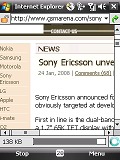
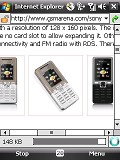
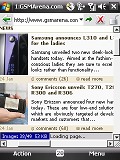
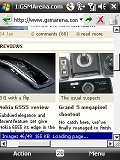
Internet Explorer and Opera Mobile are both good, but the latter has long won our hearts
Reader comments
- Marton Hamar
- 31 Oct 2019
- nw}
You can't. You may want to buy a newer phone.
- Marton Hamar
- 31 Oct 2019
- nw}
You should try to go into Settings. If you can remember which buttons do what, try to find a button for options about the system or general options (I dont know which, I'm an Android user.) Do the same with this menu until you find language options a...
- Raddedy
- 05 Mar 2017
- 3@B
where can l get this device
